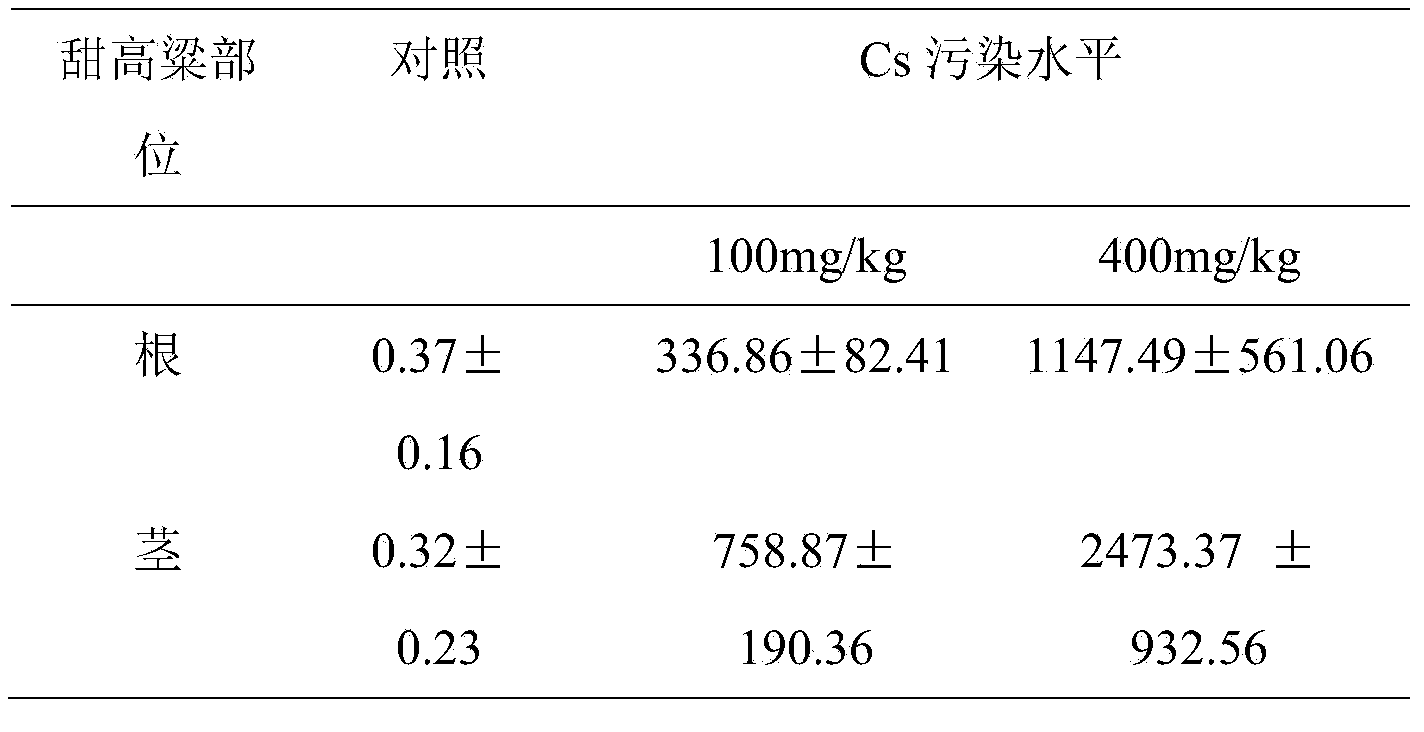Method for utilizing sorghum bicolor to restore caesium-contaminated soil
A technology for polluted soil and sweet sorghum, which is applied in the restoration of polluted soil and other directions to achieve the effects of low treatment cost, simple operation and process, and rapid growth
- Summary
- Abstract
- Description
- Claims
- Application Information
AI Technical Summary
Problems solved by technology
Method used
Image
Examples
Embodiment 1
[0025] Embodiment 1. Absorption capacity of cesium by each organ of sweet sorghum in pot test
[0026] The pot experiment site is in a farm in Dongfang City, Hainan Province. There is no pollution source around the test site, and it is an area not polluted by heavy metals. Dongfang City is located in the southwest of Hainan Province, with east longitude 108°37′ to 109°07′ and north latitude 18°43′ to 19°18′. Dongfang City has a tropical monsoon oceanic climate with abundant sunshine and an annual average temperature of 25°C. The average temperature in January is 18.4°C, and the extreme minimum temperature is 1.4°C. The average temperature in July is 29°C, and the extreme maximum temperature is 38.8°C. The average annual rainfall is about 1100 mm, and the average annual sunshine hours are about 2500 hours. The soil quality of the soil in this area is mainly sandy soil. The soil used in the pot experiment was collected from the inner surface soil of a farm in Dongfang City. T...
Embodiment 2
[0039] Example 2. The enrichment characteristics of cesium in soil by sweet sorghum
[0040] Planting, sampling and analysis steps are the same as in Example 1. However, the cesium pollution level was set to 100mgCs / kg and 400mg Cs / kg, sweet sorghum was harvested when it was mature, and the aboveground part was obtained after division, and the cesium content in the aboveground part, underground part and soil were measured and calculated respectively.
[0041] The results showed that the cesium accumulation in the shoot of sweet sorghum was more than 758 mg / kg, but only 336 mg / kg in the root, and the transfer coefficient (ratio of cesium content in the shoot and root) was more than 2.0, far greater than 1. At the same time, the concentration of cesium accumulated in the aboveground part is higher than that in the soil, that is, the enrichment factor (the ratio of cesium content in the aboveground part to that in the soil) is much greater than 1, reaching 6.4.
[0042] It can b...
Embodiment 3
[0045] Example 3. Growth status (plant height) of sweet sorghum on cesium-contaminated soil
[0046] Germinate and raise seedlings of sweet sorghum seeds in a nursery. After 3 leaves grow, seedlings with consistent growth are selected and randomly transplanted into flower pots for cultivation. The cesium pollution level is set at 40 mgCs / kg. Other planting steps are as in Example 1. The height of sweet sorghum was measured at 57 days of growth, and the results are shown in Table 4. In the 40mg Cs / kg contaminated soil, the growth of sweet sorghum was basically not affected, and its plant height was even higher than that of the control sweet sorghum.
[0047] Table 4 The height (cm) of sweet sorghum under 40mg Cs / kg cesium pollution level
[0048]
PUM
 Login to View More
Login to View More Abstract
Description
Claims
Application Information
 Login to View More
Login to View More - R&D
- Intellectual Property
- Life Sciences
- Materials
- Tech Scout
- Unparalleled Data Quality
- Higher Quality Content
- 60% Fewer Hallucinations
Browse by: Latest US Patents, China's latest patents, Technical Efficacy Thesaurus, Application Domain, Technology Topic, Popular Technical Reports.
© 2025 PatSnap. All rights reserved.Legal|Privacy policy|Modern Slavery Act Transparency Statement|Sitemap|About US| Contact US: help@patsnap.com



